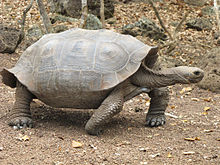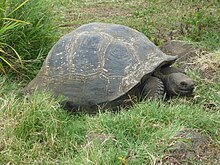Galapagos giant tortoise
| Galapagos giant tortoise | ||||||||||||
|---|---|---|---|---|---|---|---|---|---|---|---|---|

Galapagos giant tortoise ( Chelonoidis nigra porteri ) |
||||||||||||
| Systematics | ||||||||||||
|
||||||||||||
| Scientific name | ||||||||||||
| Chelonoidis nigra | ||||||||||||
| ( Quoy & Gaimard , 1824) |
The Galapagos giant tortoise ( Chelonoidis nigra ; until 2010 Geochelone elephantopus ) belongs to the genus Chelonoidis from the tortoise family (Testudinidae). 15 subspecies are described, but three or four of them are considered extinct.
Description and way of life
Distribution and biotope

The Galapagos giant tortoise lives in the Galapagos Archipelago , a group of islands in the Pacific Ocean. On the larger islands with lush vegetation in rain-damp, higher regions, there are subspecies with dome-shaped armor, the so-called "grasses". On the smaller and flatter islands, with sparse vegetation and a very hot, dry climate, live animals with saddle-shaped armor. Islands with both vegetation zones are populated by several subspecies.
The subspecies C. nigra abingdonii has been considered extinct since June 24, 2012. The last representative was Lonesome George ; he died in the Galapagos National Park when he was around 100 years old. An intensive search on the island of Pinta for a sexual partner did not unearth any further specimens of this subspecies (Pritchard 2004). There was a chance of finding something on the neighboring island of Isabela , where individual specimens with genetic characteristics of this subspecies had already been discovered.
The forms of vegetation in the habitat of the individual subspecies range from thorn bushes and cacti, especially in the lowlands near the coast, through bushes and deciduous forests to tropical forests with dense undergrowth in the higher regions. Adult animals prefer to stay in the areas with lush vegetation. However, the females migrate to the warmer coastal areas to lay their eggs, where the young animals also grow up.
Subspecies
- Wolf giant tortoise ( C. nigra becki )
- San Cristóbal Giant Tortoise ( C. nigra chathamensis )
- Santiago giant tortoise ( C. nigra darwini )
- Pinzón giant tortoise ( C. nigra duncanensis / ephippium )
- Sierra Negra giant tortoise ( C. nigra guntheri )
- Española giant tortoise ( C. nigra hoodensis )
- Darwin's giant tortoise ( C. nigra microphyes )
- Fernandina giant tortoise; Saddle back shape ( C. nigra phantastica ) (no evidence between 1906 and 2019, was considered extinct)
- Santa Cruz Giant Tortoise ( C. nigra porteri )
- Alcedo giant tortoise ( C. nigra vandenburghi )
- Cerro azul giant tortoise ( C. nigra vicina )
Extinct subspecies
- Pinta giant tortoise; Saddle back shape ( C. nigra abingdonii ), until his death in 2012 Lonesome George was the last individual, but a further 17 specimens with almost identical genes were found on the island of Pinta (Galápagos) .
- Floreana giant tortoise; Dome shape († 1846) ( C. nigra nigra )
- Rabida giant tortoise; († around 1906) ( C. nigra wallacei )
- Santa Fe giant tortoise; († around 1890) ( unnamed )
| subspecies | tank | Occurrence | Number (2010) |
|---|---|---|---|
| becki | Saddle back shape | Wolf volcano on Isabela | 1139 |
| chathamensis | intermediate shape, dome shape | San Cristobal | 1824 |
| darwini | intermediate form | San Salvador | 1165 |
| ephippium | Saddle back shape | Pinzón | 532 |
| guntheri | Dome shape | Sierra Negra volcano on Isabela | 694 |
| hoodensis | Saddle back shape | Española | 860 |
| microphyes | Dome shape | Darwin volcano on Isabela | 818 |
| porteri | Dome shape | Santa Cruz | 3391 |
| vandenburghi | Dome shape | Alcedo volcano on Isabela | 6320 |
| vicina | intermediate F, dome shape | Cerro Azul volcano on Isabela | 2574 |
As a result of the movement of subspecies to other islands in the 19th century (by whalers and pirates), hybridization occurred , i.e. the crossing of subspecies (primarily on the island of Isabela).
ancestry
There are two theories as to why there are giant tortoises on remote and very distant island groups ( Aldabra- Atoll, Seychelles and Galapagos ). According to one, smaller animals washed ashore with flotsam on the islands have developed into giant forms (Obst 1985). The second says that these giant forms on the isolated islands are the last survivors, possibly even miniatures, of their species that were once spread around the world (Pritchard 1996, Caccone 1999).
That the closest relatives of elephants turtles and Galapagos giant tortoises actually showed genetic analyzes on the Galapagos Islands ( Chelonoidis nigra ), the Patagonian Tortoise ( Chelonoidis chilensis is) from South America, while the closest relatives of Seychelles giant tortoises from Madagascar come and probably from there the Seychelles and the Mascarene Islands (Mauritius, Réunion and Rodrigues).
nutrition
Depending on the subspecies and biotope, the turtles feed on grasses, herbs, climbing plants, bushes, berries, lichens and cacti, especially opuntia .
Depending on their diet, the animals have developed differently shaped carapaces in the course of evolution, whereby subspecies that mainly feed on soil vegetation have a dome-shaped carapace. Subspecies, which mainly feed on bushes and opuntia, on the other hand, have a saddle-shaped carapace that allows greater neck movements and thus the eating of food at a greater height.
Sex differences and reproduction
Like the smaller tortoise species, giant tortoises have a pronounced sexual dimorphism . Males have longer tails, are larger, and have a concave (inwardly curved) belly armor and a flatter back armor than females. Usually they also have longer toenails on their hind legs. These secondary features only appear in the run-up to sexual maturity, in the case of the Galapagos giant tortoise from a shell length of 45–60 cm (measured over the shell vault, Mac Farland 1974). Sexual maturity is reached at the age of 20-30.
The mating season is from December to August; the females come from the cooler high altitudes to the warmer coastal areas to lay their eggs. The egg-laying season begins at the end of June and lasts until November. 4 to 17 eggs weighing between 80 and 150 g are laid. The time until the young animals hatch ( incubation period ) is up to 250 days. The hatching weight of the young is around 60–100 g. They can remain in the nest cavity for up to a month until they dig themselves to the surface together, usually after rain.
Height, maximum age

The maximum sizes for recent free-living subspecies on the Galapagos are 80 cm carapace length for females and 95 cm for males (each curved carapace length, MacFarland 1974). Animals kept in the free range reached shell lengths of 134 cm and a mass of up to 290 kg. The largest male living in captivity even weighed 422 kg (Ebersbach 2001).
Galapagos giant tortoises often get very old (see Harriet , who died in June 2006 at the age of probably 176).
Galapagos giant tortoise and human
Danger
After the discovery of the Galapagos archipelago, the population was severely decimated and five of the 15 known subspecies were completely eradicated. It is estimated that 100,000 to 200,000 animals have been killed in the past two centuries. In the recent subspecies, the population is estimated to be 12,000 to 15,000 animals. However, the population numbers are very differently distributed among the individual subspecies. The most numerous are C. nigra vandenburghi , C. nigra porteri and C. nigra becki , each with a few thousand adults. After a rescue attempt, the subspecies C. nigra hoodensis (cf. Diego ) was again represented by 2,000 animals in 2016, although it was almost extinct; In 2012, such a rescue attempt failed with the subspecies C. nigra abingdonii .
The Galapagos giant tortoise is therefore also listed in Appendix A of the Washington Convention on Endangered Species , the highest level of protection. A species protection project has been in operation on the islands themselves since 1960, the Charles Darwin Research Station , which has now brought in more than 2500 young animals and released them into the wild at three to five years of age. In addition, the station works to contain neophytes and neozoa , which are the greatest threat to biodiversity in the Galapagos. Pigs, goats, cats and rats in particular pose a threat to giant tortoises, to which clutches and young animals fall victim, as well as introduced plants that displace native plants and thus destroy the food base.
attitude
The species is currently (2020) kept in 17 European zoos, in Germany it can be seen in the Rostock and Hoyerswerda zoos. Breeding is coordinated by the Zurich Zoo as part of the European Conservation Breeding Program, but only individual animals can be assigned to a subspecies, as previously no single subspecies breeding was considered. Wild turtles are supported through ex-situ conservation projects and research on zoo specimens; So studies on the digestion and reproduction of the Galapagos giant tortoises were carried out in Zurich.
References
- ↑ Chelonoidis niger at Reptile Database, accessed June 12, 2018.
- ↑ netzeitung.de "Lonesome George" is not alone ( Memento from December 1, 2008 in the Internet Archive )
- ^ John Van Denburgh: Preliminary Description of Four New Races of Gigantic Land Tortoises from the Galapagos Islands , in: Proceedings of the California Academy of Sciences 1 (1907) 1-6 ( online ).
- ↑ Westfalen-Blatt , Herford Kreisblatt, Volume 175, Number 44/2019, February 21, 2019.
- ↑ dpa message describe in Quito , Neue Westfälische , Bielefeld Tageblatt, 209th Year, Number 44/8, February 21 of 2019.
- ↑ Lippische Landes-Zeitung , Volume 253, February 21, 2019, p. 6.
- ↑ The number is based on information from: Reproduction, breeding, repatriation, and monitoring of tortoises
- ↑ www.Zootierliste.de. Retrieved July 4, 2020 .
- ↑ Galapagos Giant Tortoise - zootier-lexikon.org. Retrieved July 4, 2020 .
literature
- Katja Ebersbach (2001): On the biology and keeping of the Aldabra giant tortoise ( Geochelone gigantea ) and the Galapagos giant tortoise ( Geochelone elephantopus ) in human care with special consideration of reproduction (PDF; 3.2 MB). - Dissertation, University of Veterinary Medicine Hannover
- Carl H. Ernst, Roger W. Barbour (1992): Turtles of the World. New York City, ISBN 1-56098-212-8
- Carl H. Ernst, RGM Altenburg, RW Barbour (1999): Turtles of the World , Win / MAC CD, ISBN 978-3-540-14547-9
- M. Pfeiffer (2000): Long-term studies of the reproductive processes in Aldabra and Galapagos giant tortoises ( Geochelone gigantea and Geochelone elephantopus ) based on steroid analyzes in the faeces and behavioral observations , dissertation, University of Zurich, IDN 960035389
- Claudia Poznik (2002): Protection programs for the Galapagos giant tortoises (Geochelone nigra, QUOY and GAIMARD 1824) on Isabela (PDF; 854 kB). - TESTUDO (SIGS), 11 (2)
- Peter Charles Howard Pritchard (1996): The Galapagos Tortoises: Nomenclatural and Survival Status , Chelonian Research Monograph No. 1 Chelonian Research Foundation, Leominster (USA), ISBN 0-9653540-0-8
Web links
- Chelonoidis nigra in the endangered Red List species the IUCN 2006. Posted by: Tortoise & Freshwater Turtle Specialist Group, 1996. Retrieved on 11 May, 2006.
- Chelonoidis nigra in The Reptile Database



